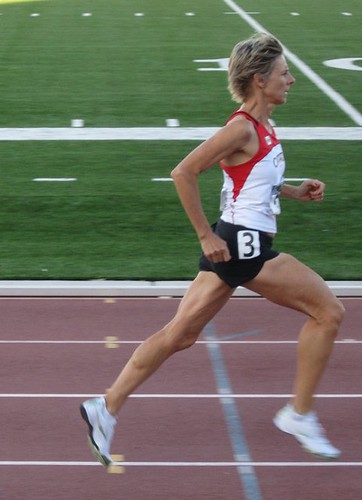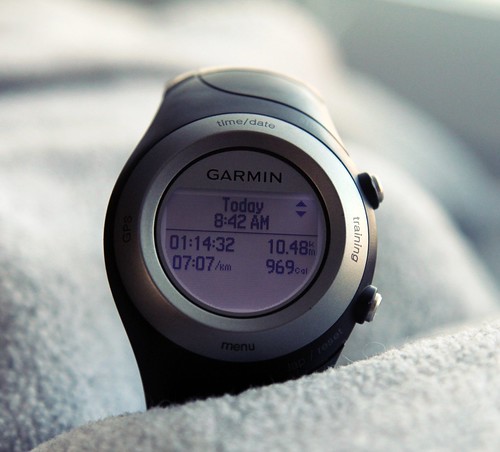 If you ask just about any endurance sports athlete or coach about their approach to training or how they quantify a training effort, they will almost certainly tell you that the standard is the use of heart rate and heart rate training zones. They will tell you that you need a heart rate monitor for effective training. They will tell you that it is an accurate means of quantifying training load.
If you ask just about any endurance sports athlete or coach about their approach to training or how they quantify a training effort, they will almost certainly tell you that the standard is the use of heart rate and heart rate training zones. They will tell you that you need a heart rate monitor for effective training. They will tell you that it is an accurate means of quantifying training load.
A quick summary of heart rate training is indicated. The athlete sets heart rate training zones (heart rate ranges) that are based on a percentage of maximum heart rate to attain various training effects. The goal of these training zones may be to improve aerobic capacity or lactate threshold - or both – as these are factors that are perceived to be related to optimal training adaptations and enhanced endurance sport performance.
But as they say, it doesn’t matter how well you build a house – if, in fact, you build the foundation on quicksand. Therein lies the basis for many training myths.
 This is the 9th in a series of RunSmart videos. The series is on-going, with a new video released on a biweekly basis. These videos complement the material presented in the book “RunSmart: A Comprehensive Approach To Injury-Free Running”. The full series of videos can be found here. A transcription of the video will also be available with each post.
This is the 9th in a series of RunSmart videos. The series is on-going, with a new video released on a biweekly basis. These videos complement the material presented in the book “RunSmart: A Comprehensive Approach To Injury-Free Running”. The full series of videos can be found here. A transcription of the video will also be available with each post.
For those of you that are interested in a more interactive learning environment, consider attending a Level One (half day), Level Two (one day), or Level Three (two day) RunSmart program. The Level One program is 3.5 hours (approved for CCU credit for physical therapists). The Level Two program is 8.5 hours and focuses on injury prevention and performance optimization. The Level Three program is a two day, 15 hour program that includes a comprehensive approach to running injuries. The next Level One program will be offered in Austin on March 24, 2012.
In this video, I will discuss “culture and training error”. The culture of the running community has changed significantly over the past 3 decades, and I would suggest that this may in fact have some relationship to training error and thus running-related injuries.
I hope you enjoy the video series. If you would like me to address any specific aspect of the RunSmart approach, drop me an email or add a comment to this article.
 Direct access to physical therapy – at least the way a consumer would view it – is the ability to make a consumer-driven choice to see a physical therapist without any limitation imposed by a gatekeeper or other entity. A consumer would also view physical therapy as the process of both evaluating a condition and implementing a treatment plan for it. I think it is safe to say that the commonly-held perspective by the consumer is that physical therapy in its entirety involves both aspects, and not just one.
Direct access to physical therapy – at least the way a consumer would view it – is the ability to make a consumer-driven choice to see a physical therapist without any limitation imposed by a gatekeeper or other entity. A consumer would also view physical therapy as the process of both evaluating a condition and implementing a treatment plan for it. I think it is safe to say that the commonly-held perspective by the consumer is that physical therapy in its entirety involves both aspects, and not just one.
The definition of “direct” is simple: “proceeding in a straight line or by the shortest course; without intervening persons, influences, factors, etc”.
But Direct Access to Physical Therapy has become a ridiculous play on words by the American Physical Therapy Association (APTA) – and a game that undermines the future of the profession at its core.
 You are now 18 days away from the Austin Marathon. You might have the goal of getting a Boston Marathon qualifying time. You might have the goal of setting a new personal best time.
You are now 18 days away from the Austin Marathon. You might have the goal of getting a Boston Marathon qualifying time. You might have the goal of setting a new personal best time.
At this point in time, you have done virtually all the training. Hopefully, you have used some sound training resources. Maybe you have listened to my CGH podcast on Marathon Training (9/1/09) or you have read “RunSmart”. You are probably within days of starting the process of peaking for the big day.
All in all, you are now on the verge of game time and you are trying to make sure that you have all the pieces in place for that epic performance that you dream of every night.
But great training can be undermined by lousy pre-race preparation. With that in mind, here are my five keys to setting a personal best at the Austin Marathon.
 This is the 8th in a series of RunSmart videos. The series is on-going, with a new video released on a biweekly basis. These videos complement the material presented in the book “RunSmart: A Comprehensive Approach To Injury-Free Running”. The full series of videos can be found here. A transcription of the video will also be available with each post.
This is the 8th in a series of RunSmart videos. The series is on-going, with a new video released on a biweekly basis. These videos complement the material presented in the book “RunSmart: A Comprehensive Approach To Injury-Free Running”. The full series of videos can be found here. A transcription of the video will also be available with each post.
For those of you that are interested in a more interactive learning environment, consider attending a RunSmart Level One, Level Two, or Level Three program. Level One focuses on Principles, Level Two on Performance and Training Program Development, and Level Three on Physiotherapy and Running Injury Recovery. CCU credit for physical therapists is available for Level One (3.5 CCU), and is pending for the complete program (15 CCU). Further CCU details will follow as they are available. The next Level One program will be offered in Austin on February 25, 2012.
In this video, I will discuss arm motions. “Crisp arms” can be used to assist the propulsive phase of gait. Most runners tend to spend little effort on their arm position or motion, but arm motions can be a very important part of improved running mechanics.
I hope you enjoy the video series. If you would like me to address any specific aspect of the RunSmart approach, drop me an email or add a comment to this article.
 It should come as no surprise to readers of this blog that I had quite a visceral response when I read the post “Visceral Manipulation Embraced By The APTA” on the website “Science-Based Medicine” (SBM).
It should come as no surprise to readers of this blog that I had quite a visceral response when I read the post “Visceral Manipulation Embraced By The APTA” on the website “Science-Based Medicine” (SBM).
Visceral manipulation. Really? C’mon APTA, are you serious? You are supposed to be the bastion of evidence-based physical therapy practice, ye of Vision 2020 and autonomy and evidence and access and ethics and …
Really? Please, say it ain’t so. Really?
If you think that you detect a bewildered look on my face, you are half right. It is bewildered and disappointed. Sadly, none of this surprises me anymore.
 This past weekend, the Olympic Trials for the marathon were held in Houston. Congratulations go out to the three men and three women who qualified to represent the United States in London this summer. On the men’s side, the team will consist of Meb Keflezighi, Ryan Hall, and Abdi Abdirahman. On the women’s side, the team will consist of Shalane Flanagan, Desiree Davila, and Kara Goucher.
This past weekend, the Olympic Trials for the marathon were held in Houston. Congratulations go out to the three men and three women who qualified to represent the United States in London this summer. On the men’s side, the team will consist of Meb Keflezighi, Ryan Hall, and Abdi Abdirahman. On the women’s side, the team will consist of Shalane Flanagan, Desiree Davila, and Kara Goucher.
Representing your country at the Olympics is a tremendous honor. Frankly, being a part of the Olympic Games – on any level – is an incredible experience. But it isn’t just about representing your country. It is also about being competitive on the world stage.
There was a time when US marathoning had a high profile on the world stage. But the last time I looked, it has been quite a while since an Olympic gold medal went to an American marathoner. With that said, and the 2012 Olympic Trials now a memory, my question is this: is the United States making any progress towards truly being an international power in the marathon once again?
 "Running Injuries: Etiology And Recovery- Based Treatment" (co-author Bridget Clark, PT) appears in the third edition and fourth editions of "Clinical Orthopaedic Rehabilitation: A Team Approach" by Charles Giangarra, MD and Robert C. Manske, PT.
"Running Injuries: Etiology And Recovery- Based Treatment" (co-author Bridget Clark, PT) appears in the third edition and fourth editions of "Clinical Orthopaedic Rehabilitation: A Team Approach" by Charles Giangarra, MD and Robert C. Manske, PT.
 Allan Besselink, PT, DPT, Ph.D., Dip.MDT has a unique voice in the world of sports, education, and health care. Read more about Allan here.
Allan Besselink, PT, DPT, Ph.D., Dip.MDT has a unique voice in the world of sports, education, and health care. Read more about Allan here.
 Top 5 finalist in three categories: "Best Overall Blog", "Best PT Blog" and "Best Advocacy Blog".
Top 5 finalist in three categories: "Best Overall Blog", "Best PT Blog" and "Best Advocacy Blog".